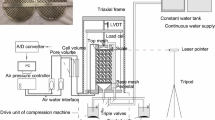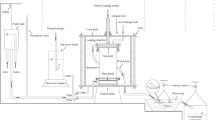Abstract
Suffusion and global backward erosion are two of the main internal erosion processes in earth structures and their foundations which may increase their failure risk. For other processes of internal erosion, different classifications exist in order to evaluate the soil erodibility, whereas in the case of suffusion and global backward erosion, no susceptibility classification is available. The absence of suffusion susceptibility classification may be due to the complexity of this process, which appears as the result of the coupled processes: detachment–transport–filtration of a part of the finest fraction within the porous network. Twelve soils, covering a large range of erodibility are tested with a specific triaxial erodimeter. Different criteria based on particle size distribution are compared in order to identify the potential susceptibility to suffusion. For the susceptibility characterization, a new energy-based method is proposed. This method can be used for cohesionless soils and clayey sand, and a single classification is obtained for suffusion tests realized under flow rate-controlled conditions or by increasing the applied hydraulic gradient. For several tests performed on a mixture of kaolinite and sand, suffusion of clay is accompanied by a global backward erosion process. Characterization of the development of clayey sand backward erosion is also addressed by this method. Finally, a complete methodology is detailed for the suffusion and global backward erosion susceptibility characterization.

















Similar content being viewed by others
References
Bendahmane F, Marot D, Alexis A (2008) Experimental parametric study of suffusion and backward erosion. J Geotech Geoenviron Eng ASCE 134(1):57–67
Bonelli S, Marot D (2011) Micromechanical modelling of internal erosion. Eur J Environ Civil Eng 15(8):1207–1224
Briaud JL (2008) Case histories in soil and rock erosion: Woodrow Wilson Bridge, Brazos River Meander, Normandy Cliffs and New Orleans Levees. J Geotech Geoenviron Eng ASCE 134(10):1425–1447
Chang DS, Zhang LM (2013a) A stress-controlled erosion apparatus for studying internal erosion in soils. Geotech Test J 34(6):579–589
Chang DS, Zhang LM (2013b) Extended internal stability criteria for soils under seepage. Soils Found 53(4):569–583
Fell R, Fry JJ (eds) (2007) Internal erosion of dams and their foundations. Taylor & Francis, London
Fell R, Fry JJ (2013) State of the art on the likelihood of internal erosion of dams and levees by means of testing, chap 1. In: Bonelli S (ed) Erosion in geomechanics applied to dams and levees. ISTE—Wiley, London, pp 1–99
Fry JJ, Vogel A, Royet P, Courivaud JR (2012) Dam failures by erosion: lessons from ERINOH data bases. In: Proceedings of 6th international conference on scour and erosion (ICSE-6), 27–31 August, Paris, France, pp 273–280
Garner SJ, Fannin RJ (2010) Understanding internal erosion: a decade of research following a sinkhole event. Int J Hydropower Dams 17:93–98
Haghighi I (2012) Caractérisation des phénomènes d’érosion et de dispersion: développement d’essais et applications pratiques. Ph.D. Thesis. Université Paris-Est
Hanson GJ, Simon A (2001) Erodibility of cohesive streambeds in the loess area of the Midwestern, USA. Hydrol Process 15(1):23–38
Ke L, Takahashi A (2012) Strength reduction of cohesionless soil due to internal erosion induced by one dimensional upward seepage flow. Soils Found 52(2012):698–711
Kenney TC, Lau D (1985) Internal stability of granular filters. Can Geotech J 22:215–225
Kovacs G (1981) Seepage hydraulic. Elsevier, Amsterdam
Lafleur J (1999) Selection of geotextiles to filter broadly graded cohesionless soils. Geotext Geomembr 17:299–312
Lafleur J, Mlynarek J, Rollin AL (1989) Filtration of broadly graded cohesionless soils. J Geotech Eng 115(12):1747–1768
Li M, Fannin J (2008) Comparison of two criteria for internal stability of granular soil. Can Geotech J 45:1303–1309
Luo YL, Qiao L, Liu XX, Zhan ML, Sheng JC (2013) Hydro-mechanical experiments on suffusion under long-term large hydraulic heads. Nat Hazards 65:1361–1377
Marot D, Bendahmane F, Rosquoët F, Alexis A (2009) Internal flow effects on isotropic confined sand-clay mixtures. Soil Sediment Contam 18(3):294–306
Marot D, Regazzoni PL, Wahl T (2011a) Energy based method for providing soil surface erodibility rankings. J Geotech Geoenviron Eng ASCE 137(12):1290–1294
Marot D, Bendahmane F, Konrad JM (2011b) Multi-channel optical sensor to quantify particle stability under seepage flow. Can Geotech J 48:1772–1787
Marot D, Bendahmane F, Nguyen HH (2012) Influence of angularity of coarse fraction grains on internal erosion process. La Houille Blanche 6:47–53
Moffat R, Fannin J (2006) A large permeameter for study of internal stability in cohesionless soils. Geotech Test J 29(4):273–279
Moffat R, Fannin RJ, Garner SJ (2011) Spatial and temporal progression of internal erosion in cohesionless soil. Can Geotech J 48(3):399–412
Nguyen HH, Marot D, Bendahmane F (2012) Erodibility characterisation for suffusion process in cohesive soil by two types of hydraulic loading. La Houille Blanche 6:54–60
Reddi LN, Lee I, Bonala MVS (2000) Comparison of internal and surface erosion using flow pump test on a sand-kaolinite mixture. Geotech Test J 23(1):116–122
Sibille L, Lominé F, Poullain P, Sail Y, Marot D (2015a) Internal erosion in granular media: direct numerical simulations and energy interpretation. Hydrol Process 29(9):2149–2163. doi:10.1002/hyp.10351
Sibille L, Marot D, Sail Y (2015b) A description of internal erosion by suffusion and induced settlements on cohesionless granular matter. Acta Geotech 10:735–748. doi:10.1007/s11440-015-0388-6
Wan CF, Fell R (2004) Investigation of rate of erosion of soils in embankment dams. J Geotech Geoenviron Eng ASCE 130(4):373–380
Wan CF, Fell R (2008) Assessing the potential of internal instability and suffusion in embankment dams and their foundations. J Geotech Geoenviron Eng ASCE 134(3):401–407
Wörman A, Olafsdottir R (1992) Erosion in a granular medium interface. J Hydraul Res 30(5):639–655
Acknowledgements
The authors thank the World Bank (Project TRIG. University of Danang. Vietnam), the French National Research Agency (ANR-ERINOH) and the French Institute for Applied Research and Experimentation in Civil Engineering (IREX) for providing financial support for this work. The support from Indonesian Government is also gratefully acknowledged.
Author information
Authors and Affiliations
Corresponding author
Rights and permissions
About this article
Cite this article
Marot, D., Rochim, A., Nguyen, HH. et al. Assessing the susceptibility of gap-graded soils to internal erosion: proposition of a new experimental methodology. Nat Hazards 83, 365–388 (2016). https://doi.org/10.1007/s11069-016-2319-8
Received:
Accepted:
Published:
Issue Date:
DOI: https://doi.org/10.1007/s11069-016-2319-8




